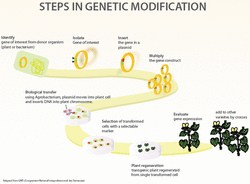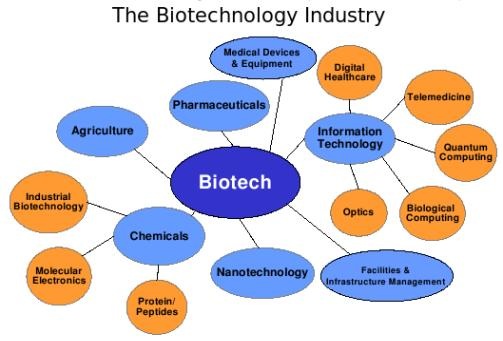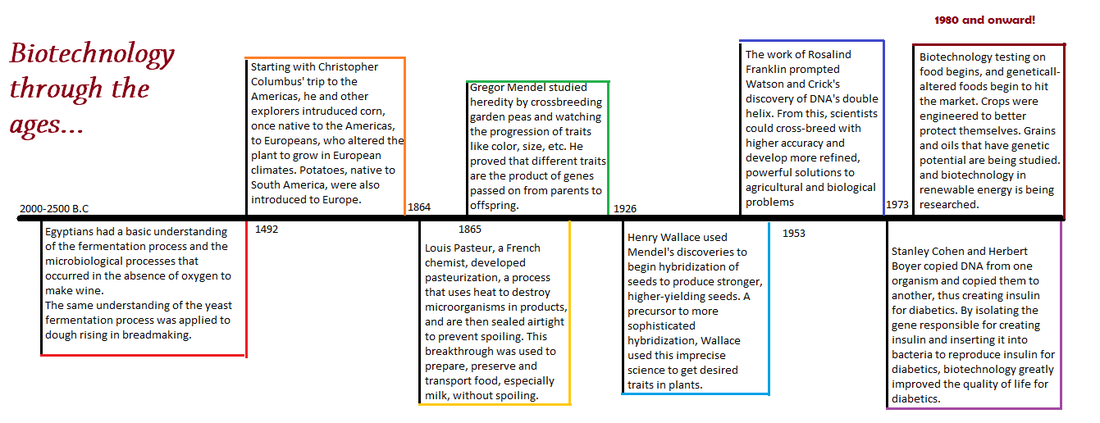An Introduction to Biotechnology
Biotechnology uses cellular and biomolecular processes to develop technology and products to improve lives and the planet. Simple examples of biotechnology include food processes, such as microorganisms that make cheese, bread, yogurt and more possible. More advanced biotechnologies available include insecticides and pesticides used by farmers to increase agricultural yield, biofuels and chemicals from renewable biomass to decrease greenhouse gas emission, and biocatalysts to streamline steps in chemical manufacturing (x).
The History of Biotechnology
(x)
How Biotechnology Works
 Click image to enlarge
Click image to enlarge Biotechnologists use enzymes to cut away DNA nucleotides (see DNA transcription to mRNA and mRNA translation to proteins for more information on that) and replace or combine the DNA in other organisms. This process, known as recombinant DNA or rDNA technology is used throughout biotechnology. rDNA technology makes it possible for scientists to move genetic information to and from unrelated organisms in order to cultivate the desired traits.
(x) (x)
(x) (x)
Biotechnology Today
Food and Livestock:
- Simple biotechnology: yeast fermentation to make dough rise for bread, letting grapes ferment to make wine, breeding animals or plants together to get ideal characteristics.
- Genetic engineering: genetically modified organisms with biological defense to withstand weather conditions, disease and insect attacks. Animals can be vaccinated against diseases and injected with bacteria to keep them healthy and to make the resulting animal products more desirable.
- Plants that are biologically protected from insects reduce the need for pesticides, thus protecting the environment from harmful chemicals. Fruits and vegetables have been altered to ripen longer on the vine/plant/bush/etc but still have a long shelf life, due to altered pectin degradation. Plants have also been engineered to taste better, or have starch, iron, etc added to them, to make them healthier.
- Most cheeses are made with a genetically engineered bacteria enzyme called chymosin, supposed purer than its organic counterpart, rennet.
- Modern molecular biology is used to improve efficiency and reduce the impact on the environment in industrial processes.
- Biocatalysts, like enzymes, are used to synthesize chemicals at a commercial quantity, while being both economically and environmentally friendly.
- For example, proteases are used in detergents to break down starch, proteins and fatty acids. The production of this results in a byproduct of an organic fertilizer.
- Biotechnology can be used as a substitute-- corn can be used instead of petroleum to produce chemicals.
- Bio technology can be used to aid the environment in waste treatment and pollution prevention-- to efficiently clean up waste and reduce the need for land-based disposal.
- Bioremediation: introducing nutrients to soil to stimulate bacteria already there or add new bacteria to waste soil. The bacteria consumes the waste, and once it is all gone, the bacteria either die off or return to their normal numbers in the environment.
- Enzyme bioreactors can be added to industrial and food waste to be removed through the sewage system as opposed to solid waste disposal mechanisms.
- Waste can have enzymes added that convert it to biofuel.


